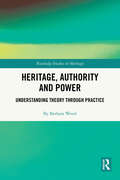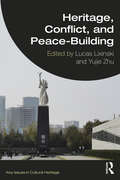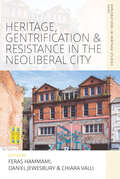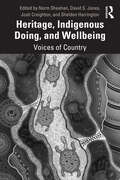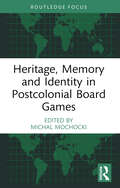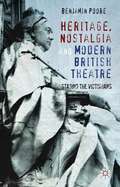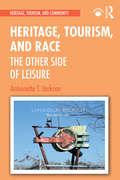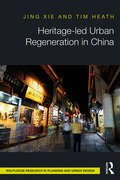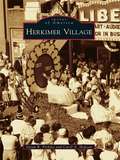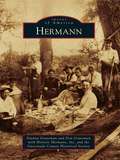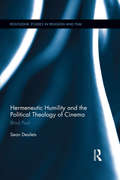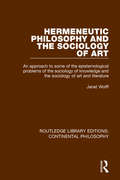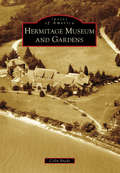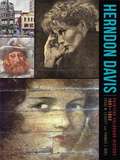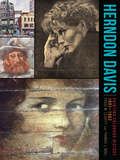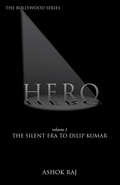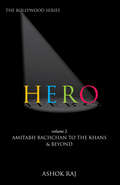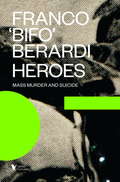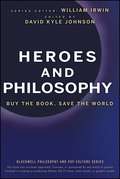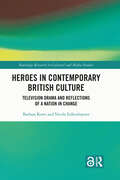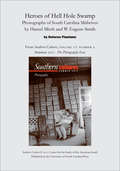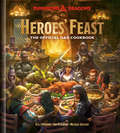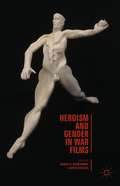- Table View
- List View
Heritage, Authority and Power: Understanding Theory Through Practice (Routledge Studies in Heritage)
by Barbara WoodHeritage, Authority and Power - Understanding Theory Through Practice examines who holds power and authority in heritage, the connection with specialist knowledge and what the shifting nature of these attributes means for concepts of authenticity.Drawing on interviews with practitioners working across the heritage sector, Wood explores why in some organisations staff feel disempowered, but in others they thrive. In exploring the worked experience of practitioners, a new model emerges for understanding the sector that recognises the differences between the activity of heritage and the work of professional practice. The model demonstrates that the sector is unknowingly operating with two different purposes, The activity of heritage, generated by and from, the collections of the past, is inventive, creative and entertaining, but operates for contemporary need and interest. The work of professional practice, meanwhile, although itself creative and supporting and enabling the work of heritage, is fundamentally concerned with long-term collection development, research and conservation. In recognising and embracing these differences, the function of specialist practice in relation to curatorship can be appreciated, but so too can the contribution of supporting specialisms, such as education, outreach, community engagement and design. The model presented within the book subsequently offers a more efficient and effective, forward-looking way to think about funding, organising and managing these two areas separately – but also in active partnership.Heritage, Authority and Power is situated in the space between academia and practice and is useful for students, practitioners and for anyone interested, managing or working in heritage. It will be particularly relevant to academics and students engaged in the study of heritage, museums, tourism and visitor experience, and public history.
Heritage, Conflict, and Peace-Building (ISSN)
by Lucas Lixinski Yujie ZhuHeritage, Conflict, and Peace-Building examines the possibilities arising from, and challenges associated with, transforming heritage from a casualty of conflict into an opportunity for peacebuilding.The contributors to this book, who hail from academia and practice, present case studies that shed light on the multifaceted factors and conditions influenced by diplomacy, nationalism, victimhood, and the roles of diverse institutional actors in fostering peace. They demonstrate the possibilities and pitfalls of the work heritage does for local communities, the nation-state, and the international community, when these different actors and their peace aspirations and agendas intersect. Looking at heritage and peace processes on all continents, the contributions in this volume amount to a compelling analytical account of how the discourses of heritage and peace connect, overlap, and diverge. They also emphasise that our shared aspiration for peace should not be taken for granted in a heritage context, and that it is incumbent upon heritage scholars and practitioners to be more intentional about the work they wish to do to promote peace.Heritage, Conflict, and Peace-Building will be of interest to scholars and practitioners working in heritage studies, transitional justice, museum studies, international relations, education, history, and law.
Heritage, Gentrification and Resistance in the Neoliberal City (Explorations in Heritage Studies #5)
by Chiara Valli Feras Hammami, Daniel JewesburyWhat happens when versions of the past become silenced, suppressed, or privileged due to urban restructuring? In what ways are the interpretations and performances of ‘the past’ linked to urban gentrification, marginalization, displacement, and social responses? Authors explore a variety of attempts to interrupt and interrogate urban restructuring, and to imagine alternative forms of urban organization, produced by diverse coalitions of resisting groups and individuals. Armed with historical narratives, oral histories, objects, physical built environment, memorials, and intangible aspects of heritage that include traditions, local knowledge and experiences, memories, authors challenge the ‘devaluation’ of their neighborhoods in official heritage and development narratives.
Heritage, Indigenous Doing, and Wellbeing: Voices of Country
by David S. Jones Norm Sheehan Josh Creighton Sheldon HarringtonHeritage, Indigenous Doing and Wellbeing presents an Australian Aboriginal relational understanding of the world that offers a counter-narrative to the Western notion of heritage towards new insights into the potential for sustaining the complex systems that support all life. From an Indigenous Australian perspective, the Western concept of heritage is intentionally exclusionary and supports social, political, economic and environmental injustice. Aboriginal people engage with Australia’s lands, waters, and skies every day in entirely different ways, seeing their Country as a living ‘heritage’, but in a unique relationship that engages the individual with Place, Ancestors, Language, and wellbeing analogous to a familial relationship. However, Country is most often relegated by heritage proponents to ‘intangible heritage’ resulting in the concept having little legislative, legal or administrative weight. Drawing on a common understanding of Country as sacred, living and sentient, rather than as objectified property or resource, the contributors to this book explore a diversity of relationships with Country that demonstrate the richness and the practical utility of this relational understanding. Heritage, Indigenous Doing and Wellbeing foregrounds the voices of Australian Aboriginal Peoples who are involved in ‘Caring for Country’. The book offers an essential resource for those engaged in the study of Country, heritage, museums, Indigenous Peoples, First Nations Peoples, landscape architecture, environmental studies, planning, anthropology and archaeology. It will also be of great interest to heritage practitioners working around the globe.
Heritage, Memory and Identity in Postcolonial Board Games
by Michal MochockiHeritage, Memory and Identity in Postcolonial Board Games is a unique edited collection that explores the interplay of heritage, memory, identity and history within postcolonial board games and their surrounding paratexts. It also examines critiques of these games within the gamer communities and beyond. Drawing on a range of international contributions, examples and case studies, this book shows how colonialism-themed games work as representations of the past that are influenced by existing heritage narratives and discourses. It also considers the implications of using colonial histories in games and its impact on its audience, the games’ players. Heritage, Memory and Identity in Postcolonial Board Games will be relevant to scholars and postgraduate students in the fields of game studies, game design or development, heritage studies, postcolonial criticism, media studies, and history. It will also be beneficial to practicing game developers.
Heritage, Nostalgia and Modern British Theatre
by Benjamin PooreThe Victorians, having once been seen as 'them', the age responsible for the mistakes of the past, were transformed by the new theatrical forms of the 1960s into 'us', a metaphor for what the nation thinks (and fears) about itself. And, since the 1980s and the rise of new biographical forms in the theatre, the emphasis has shifted further, from 'we' to 'me': plays about individuals, great and small, and their struggles for personal validation. This study argues powerfully that the stage portrayal of the Victorians in recent times is a key reference point in understanding notions of Britishness, heritage and nostalgia, and the profound politicisation of national identity over the last four decades. Using many examples drawn from theatre archives, and throwing new light on works by canonical playwrights like Bond, Edgar, and Churchill, it charts the decline in class-based narratives of the British people and the move towards plays reflecting a more atomised, individuated society, preoccupied with identity and the past but no longer able to provide a convincing account of itself as a nation.
Heritage, Photography, and the Affective Past (UCL Institute of Archaeology Critical Cultural Heritage Series)
by Colin SterlingHeritage, Photography, and the Affective Past critically examines the production, consumption, and interpretation of photography across various heritage domains, from global image archives to the domestic arena of the family album. Through original ethnographic and archival research, the book sheds new light on the role photography has played in the emergence, expansion, and articulation of heritage in diverse sociocultural contexts. Drawing on wide-ranging experience across the heritage sector and two international case studies – Angkor in Cambodia and the town of Famagusta, Cyprus – the book makes a major contribution to our understanding of the role photography has played and continues to play in shaping experiences and conceptualisations of heritage. One of the core aims of the book is to problematise and potentially redirect the varied usages of photography within current practice, usages which remain woefully undertheorised, despite their often-central role in shaping heritage. Ultimately, by focusing attention on a hitherto underexamined aspect of the heritage phenomenon, namely its manifold interconnections with photography, this book provides fresh insight to the making and remaking of the past in the present, and the alternative heritages that might come into being around emergent photographic forms and approaches. Heritage, Photography, and the Affective Past uses photography as a method of enquiry as well as a tool of documentation. It will be of interest to scholars and students of heritage, photography, anthropology, museology, public archaeology, and tourism. The book will also be a valuable resource for heritage practitioners working around the globe.
Heritage, Tourism, and Race: The Other Side of Leisure (Heritage, Tourism, and Community)
by Antoinette T JacksonHeritage, Tourism, and Race views heritage and leisure tourism in the Americas through the lens of race, and is especially concerned with redressing gaps in recognizing and critically accounting for African Americans as an underrepresented community in leisure. Fostering critical public discussions about heritage, travel, tourism, leisure, and race, Jackson addresses the underrepresentation of African American leisure experiences and links Black experiences in this area to discussions of race, place, spatial imaginaries, and issues of segregation and social control explored in the fields of geography, architecture, and the law. Most importantly, the book emphasizes the importance of shifting public dialogue from a singular focus on those groups who are disadvantaged within a system of racial hierarchy, to those actors and institutions exerting power over racialized others through practices of exclusion. Heritage, Tourism, and Race will be invaluable reading for academics and students engaged in the study of museums, as well as architecture, anthropology, public history, and a range of other disciplines. It will also be of interest to museum and heritage professionals and those studying the construction and control of space and how this affects and reveals the narratives of marginalized communities.
Heritage-led Urban Regeneration in China
by Tim Heath Jing XieUrban planning, regeneration and design is an essentially cultural practice with the outcomes often depending upon an understanding of and engagement with the past. As cities in China strive to be competitive and attractive on the world stage, their decaying historical urban fabrics are being transformed into vibrant places through historical-cultural led urban regeneration, however, the impact of their rapid development has escaped serious scrutiny. Heritage-led Urban Regeneration in China presents the detailed evolution of three well-known historic streets in China: the Southern Song Imperial Street in Hangzhou; the residential Pingjiang Street in Suzhou; and the commercial Tunxi Old Street in Huangshan. From their original formation to their more recent regeneration, this book offers a critical evaluation of historical-cultural led urban regeneration projects in China and provides theoretical guidelines for contemporary practice in relation to its tangible and intangible urban heritage. Using interdisciplinary research in architecture, urban design, history and cultural studies, Jing Xie and Tim Heath provide a detailed analysis of the conservation and regeneration efforts of China as an emerging and pivotal world power. An invaluable resource for urban designers, urban planners and architects interested in and working in China, Heritage-led Urban Regeneration in China helps its readers to engage with the essential and invisible factors that produce these revitalised places while forming a critical view towards these projects.
Herkimer Village (Images of America)
by Caryl A. Hopson Susan R. PerkinsThe village of Herkimer, incorporated on April 6, 1807, was the first village in Herkimer County and was named after Revolutionary War hero Gen. Nicholas Herkimer. First settled by the Palatine Germans in 1725, the village's ideal location at the juncture of the Mohawk River and West Canada Creek made it the focal point of the county, and it was soon designated the county seat. The village population grew with the development of mills and factories, prompting the construction of elaborate homes, churches, diverse shops, and the New York Central Railroad, which ran directly through the village center with four main line tracks. Herkimer Village provides a snapshot of the daily life and important events in this village's colorful and dynamic history.
Hermann
by Washington Historical Society Don Graveman Dianna GravemanHermann, Missouri, was named for Hermann der Cherusker, a German folk hero of the first century who led a successful battle against the Romans that many feel changed the course of history. In 1837, the German Settlement Society of Philadelphia, whose members hoped to establish a colony where their German language and customs could be preserved, founded Hermann and named the town for the young warrior. By the turn of the century, Hermann was a thriving river port and growing wine producer. The Hermann American Viticultural Area was officially designated in 1983, one of the earliest to be recognized by the U.S. government. Hermann hosts many events each year, including Maifest, which featured a historic pageant in the years 1952 through 1964, and Wurstfest, a celebration of the art of German sausage making. Approximately a quarter of a million tourists visit Hermann each year to enjoy a taste of "Little Germany" in the heart of the American Midwest.
Hermeneutic Humility and the Political Theology of Cinema: Blind Paul (Routledge Studies in Religion and Film)
by Sean DesiletsThis book revisits the tradition of Western religious cinema in light of scholarship on St. Paul’s political theology. The book’s subtitle derives from the account in the Book of Acts that St. Paul was temporarily blinded in the wake of his conversion on the road to Damascus. In imitation of Paul, the films on which Sean Desilets’s analysis hinges (including those of Carl-Th. Dreyer, Robert Bresson, Pier Paolo Pasolini, and Carlos Reygadas) place a god-blind mechanism, the camera, between themselves and the divine. Desilets calls the posture they adopt "hermeneutic humility": hermeneutic in that it interprets the world, but humble in that it pays particular—even obsessive—attention to its own limits. Though these films may not consciously reflect Pauline theology, Desilets argues that they participate in a messianic-hermeneutic tradition that runs from Paul through St. Augustine, Blaise Pascal, Karl Barth, and Walter Benjamin, and which contributes significantly to contemporary discussions in poststructuralist literary theory, political theology, and religious studies. Desilets’s insightful explication of Jean-Luc Nancy’s deconstruction of Christianity and Georgio Agamben’s recent work on religion makes a substantial contribution to film philosophy and emerging critical trends in the study of religion and film. This book puts forward a nuanced theoretical framework that will be useful for film scholars, students of contemporary political theology, and scholars interested in the intersections of religion and media.
Hermeneutic Philosophy and the Sociology of Art: An Approach to Some of the Epistemological Problems of the Sociology of Knowledge and the Sociology of Art and Literature (Routledge Library Editions: Continental Philosophy #4)
by Janet WolffThis book, first published in 1975, is an examination of the theoretical foundation of the sociology of art and literature and an in-depth study in the sociology of knowledge. In discussing and clarifying some of the important philosophical issues in this field, the constant underlying reference is to the creative and artistic-expressive areas of knowledge – so that the better understanding of the social nature and genesis of all knowledge may point the way towards a similar comprehension of art and society.
Hermitage Museum and Gardens (Images of America)
by Colin BradyIn 1907, William and Florence Sloane began construction on a five-room summer cottage on the banks of the Lafayette River in Norfolk. Over the course of 30 years, they would expand their home from its origins as a summer retreat into a 42-room Arts and Crafts mansion nestled on 12 acres of gardens and grounds. As their home grew, so did their desire to bring an arts scene to southeastern Virginia. In 1937, the Sloanes turned their attention to repurposing their home as a museum. By opening the site to the public, the Sloane family created a new space for the arts and education in Norfolk. Today, visitors continue to enjoy their vision through an expansive art collection and acres of gardens and grounds.
Herndon Davis
by Thomas J. Noel Craig Leavitt"Herndon Davis, an artist and journalist, dedicated his life to depicting the major landmarks and personalities of Colorado in watercolor, oil, pen, and pencil. Best known for the Face on the Barroom Floor, the portrait of an alluring woman on the floor of the Teller House Hotel barroom in Central City, Colorado, Davis was a prolific artist whose murals, sketches, and portraits can be found all over the state, from the Sage Room of the Oxford Hotel on Seventeenth Street to the Denver Press Club poker room. Despite his numerous contributions, his work was never showcased or exhibited in the traditional manner.In this biography and first-ever collection featuring most of his life's work, authors Craig Leavitt and Thomas J. Noel provide a detailed look into Davis's life and career and include a catalog of almost 200 photographs of his work from Colorado and around the country. They also put his work into the broader context of the time through comparison with such contemporary Colorado artists as Muriel Sibell Wolle, Allen Tupper True, Charles Waldo Love, and Juan Menchaca.Published to coincide with the Denver Public Library's 2016 exhibition--the only public display of Davis's work to date--and bringing deserved attention to this overlooked figure, Herndon Davis: Painting Colorado History, 1901-1962 is an important contribution to Colorado's cultural history.This book and the accompanying exhibit are sponsored by the Western History/Genealogy Department at the Denver Public Library. Publication originated and supported in part by Diane B. Wunnike."
Herndon Davis: Painting Colorado History, 1901–1962
by Thomas J. Noel Craig LeavittHerndon Davis, an artist and journalist, dedicated his life to depicting the major landmarks and personalities of Colorado in watercolor, oil, and pen and pencil. Best known for the Face on the Barroom Floor, the portrait of an alluring woman on the floor of the Teller House Hotel barroom in Central City, Colorado, Davis was a prolific artist whose murals, sketches, and portraits can be found all over the state, from the Sage Room of the Oxford Hotel on Seventeenth Street to the Denver Press Club poker room. Despite his numerous contributions, his work was never showcased or exhibited in the traditional manner. In this biography and first-ever collection featuring most of his life’s work, authors Craig Leavitt and Thomas J. Noel provide a detailed look into Davis’s life and career and include a catalog of almost 200 photographs of his work from Colorado and around the country. They also put his work into the broader context of the time through comparison with such contemporary Colorado artists as Muriel Sibell Wolle, Allen Tupper True, Charles Waldo Love, and Juan Menchaca. Published to coincide with the Denver Public Library’s 2016 exhibition—the only public display of Davis’s work to date—and bringing deserved attention to this overlooked figure, Herndon Davis: Painting Colorado History, 1901-1962 is an important contribution to Colorado’s cultural history. This book and the accompanying exhibit are sponsored by the Western History/Genealogy Department at the Denver Public Library. Publication originated and supported in part by Diane B. Wunnike.
Hero Vol.1: The Silent Era To Dilip Kumar
by Ashok RajThis volume traces the growth of the indigenous Hindi film hero from the silent era up to Dilip Kumar. The film hero is depicted as a credible representative of the social, cultural and political milieu of his era. The author contends that the development of Hindi cinema has been largely centered round the frontal figure of the hero. In the course of the narrative, the subject matter presents a compact history of mainstream Hindi cinema by placing personalities, events and trends in specific time frames.
Hero Vol.2: Amitabh Bachchan To The Khans And Beyond
by Ashok RajThis volume focuses on the life and times of the ‘star of the millennium’, Amitabh Bachchan, and goes on to describe his contemporaries such as Shashi Kapoor, Dharmendra and Vinod Khanna, and also the next generation of heroes, including the Khans, Govinda, Hrithik Roshan and others who have followed. Ashok Raj is a research coordinator based in New Delhi. An alumnus of the Indian Institute of Technology, New Delhi, he has served as a consultant to several national and international organizations and NGOs in various spheres such as science, culture and the media. His significant work is a sixteen-part series on cinema, which was published in Screen (in 1988).
Heroes
by Franco Bifo" BerardiWhat is the relationship between capitalism and mental health? In his most unsettling book to date, Franco "Bifo" Berardi embarks on an exhilarating journey through philosophy, psychoanalysis and current events, searching for the social roots of the mental malaise of our age. Spanning an array of horrors - the Aurora "Joker" killer; Anders Breivik; American school massacres; the suicide epidemic in Korea and Japan; and the recent spate of "austerity" suicides in Europe - Heroes dares to explore the darkest shadow cast by the contemporary obsession with relentless competition and hyper-connectivity. In a volume that crowns four decades of radical intellectual work, Berardi develops the psychoanalytical insights of his friend Félix Guattari and proposes dystopian irony as a strategy to disentangle ourselves from the deadly embrace of absolute capitalism.From the Trade Paperback edition.
Heroes and Philosophy: Buy the Book, Save the World
by David K. JohnsonThe first unauthorized look at the philosophy behind Heroes, one of TV's most popular shows. When ordinary individuals from around the world inexplicably develop superhuman abilities, they question who they are, struggle to cope with new responsibilities, and decide whether to use their new power for good or for evil. Every episode of Tim Kring's hit TV show "Heroes" is a philosophical quandary. Is the Company evil, or good? Does Hiro really have a destiny? Do we? Is it okay to lie in order to hide your powers or save the world? "Heroes and Philosophy" offers answers to these and other intriguing questions. Brings the insight of history's philosophical heavyweights such as Plato and Nietzche to Heroes characters and settings. Adds a fun and fascinating dimension to your understanding of the show. Expands your thinking about Heroes as the series expands from graphic and text novels to action figures and a video game. Whether you're new to Heroes or have been a fan since day one, this book will take your enjoyment of the show to the next level.
Heroes in Contemporary British Culture: Television Drama and Reflections of a Nation in Change (Routledge Research in Cultural and Media Studies)
by Nicole Falkenhayner Barbara KorteThis book explores how British culture is negotiating heroes and heroisms in the twenty-first century. It posits a nexus between the heroic and the state of the nation and explores this idea through British television drama. Drawing on case studies including programmes such as The Last Kingdom, Spooks, Luther and Merlin, the book explores the aesthetic strategies of heroisation in television drama and contextualises the programmes within British public discourses at the time of their production, original broadcasting and first reception. British television drama is a cultural forum in which contemporary Britain’s problems, wishes and cultural values are revealed and debated. By revealing the tensions in contemporary notions of heroes and heroisms, television drama employs the heroic as a lens through which to scrutinise contemporary British society and its responses to crisis and change. Looking back on the development of heroic representations in British television drama over the last twenty years, this book’s analyses show how heroisation in television drama reacts to, and reveals shifts in, British structures of feeling in a time marked by insecurity. The book is ideal for readers interested in British cultural studies, studies of the heroic and popular culture.
Heroes in Contemporary British Culture: Television Drama and Reflections of a Nation in Change (Routledge Research in Cultural and Media Studies)
by Nicole Falkenhayner Barbara KorteThis book explores how British culture is negotiating heroes and heroisms in the twenty-first century. It posits a nexus between the heroic and the state of the nation and explores this idea through British television drama.Drawing on case studies including programmes such as The Last Kingdom, Spooks, Luther and Merlin, the book explores the aesthetic strategies of heroisation in television drama and contextualises the programmes within British public discourses at the time of their production, original broadcasting and first reception. British television drama is a cultural forum in which contemporary Britain’s problems, wishes and cultural values are revealed and debated. By revealing the tensions in contemporary notions of heroes and heroisms, television drama employs the heroic as a lens through which to scrutinise contemporary British society and its responses to crisis and change. Looking back on the development of heroic representations in British television drama over the last twenty years, this book’s analyses show how heroisation in television drama reacts to, and reveals shifts in, British structures of feeling in a time marked by insecurity.The book is ideal for readers interested in British cultural studies, studies of the heroic and popular culture.Introduction of this book is freely available as a downloadable Open Access PDF at http://www.taylorfrancis.com under a Creative Commons [Attribution (CC-BY-)] 4.0 license.
Heroes of Hell Hole Swamp: Photographs of South Carolina Midwives by Hansel Mieth and W. Eugene Smith
by Dolores FlamianoTwo mid-century Life photo essays reveal the power of editorial selection to lie—or reveal truth. This article appears in the Summer 2011 issue of Southern Cultures: The Photography Issue. "Mieth and Smith shared a belief that photography could bring social change. They viewed Pat Clark and Maude Callen as heroic healers whose stories would inspire racial understanding. Both photographers shot powerful images of the most visceral human experiences: birth, death, sexuality, and disease." Note: Due to copyright restrictions, the original photos by Mieth and Smith are available in the print version only.
Heroes' Feast: The Official D&D Cookbook (Dungeons & Dragons)
by Michael Witwer Kyle Newman Jon Peterson Official Dungeons & Dragons Licensed80 recipes inspired by the magical world of Dungeons & Dragons &“Ready a tall tankard of mead and brace yourself for a culinary journey to match any quest!&”—Tom Morello, Rage Against the Machine From the D&D experts behind Dungeons & Dragons Art & Arcana comes a cookbook that invites fantasy lovers to celebrate the unique culinary creations and traditions of their favorite fictional cultures. With this book, you can prepare dishes delicate enough to dine like elves and their drow cousins or hearty enough to feast like a dwarven clan or an orcish horde. All eighty dishes—developed by a professional chef—are delicious, easy to prepare, and composed of wholesome ingredients readily found in our world.Heroes&’ Feast includes recipes for snacking, such as Elven Bread, Iron Rations, savory Hand Pies, and Orc Bacon, as well as hearty vegetarian, meaty, and fish mains, such as Amphail Braised Beef, Hommlet Golden Brown Roasted Turkey, Drow Mushroom Steaks, and Pan-Fried Knucklehead Trout—all which pair perfectly with a side of Otik&’s famous fried spiced potatoes. There are also featured desserts and cocktails—such as Heartlands Rose Apple and Blackberry Pie, Trolltide Candied Apples, Evermead, Potion of Restoration, and Goodberry Blend—and everything in between, to satisfy a craving for any adventure.
Heroism And Gender In War Films
by Karen A. Ritzenhoff Jakub KazeckiFilmic constructions of war heroism have a profound impact on public perceptions of conflicts. Here, contributors examine the ways motifs of gender and heroism in war films are used to justify ideological positions, shape the understanding of the military conflicts, support political agendas and institutions, and influence collective memory.
